Dragon Force: The Soul of the Sega Saturn?
When it comes to games that define the Sega Saturn, thereís certainly a number of contenders, not least because in the absence of a mainline Sonic game, the console was left without a true mascot.
NiGHTS into Dreams is often a game touted to fill that void for a number of reasons, Virtua Fighter 2 as the consoles best selling game and its early visual benchmark is another. Sega Rally could define the Sega Saturn for obvious reasons, while Panzer Dragoon and its sequels defined the Saturn with a trilogy that was not only well received but in totality remains exclusive to the system today.
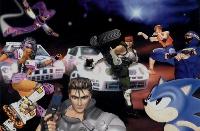
All of these and so many more could be position as
the
game that defined the Saturn.
But thereís an alternative that Iíd like to offer up, a game that utilised the Sega Saturnís unique strengths, a game that exemplifies the sort of unique creativity Sega exuded in that era, that flaunted the 2D prowess the Saturn would be renowned for and would remain exclusive to the Saturn in the West:
Dragon Force!
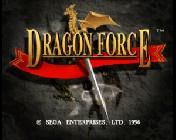
The tale of Dragon Force begins with another Force, that of J-Force. An offshoot of the iconic Wolf Team (wolf Team Mega CD logo). This small but talented team had been established by Masahiro Akishiro, the Producer behind some of Wolf Teamís biggest hits, such as the El Viento trilogy, Cobra Command, Sol Feace and Road Avenger.
Between 1994 and 1995, they produced five games that represented quite an eclectic mix from puzzle games to visually impressive RPGís, and with the advent of the 32-bit era, they began to work on perhaps their most ambitious game yet.
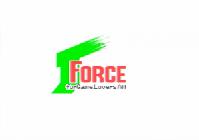
Built for the new Sega Saturn console with its unprecedented power for 2D visuals, this game would blend numerous genres together in a new and innovative way.
But then, disaster struck. J-Force, beset by project delays and financial problems, saw their figurehead, Masahiro Akashino, disappear. His whereabouts remain a mystery to this day, and with their most important and influential designer ó not to mention the companyís head ó now missing, J-Force would fall into bankruptcy and their remaining projects would be scattered to the winds.
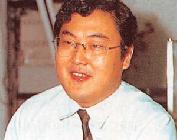
Thankfully, Sega saw the potential of the Dragon Force project and would pick up where J-Force left off. Pulling a team of experienced Sega alumni together ó featuring the likes of Hiroshi ba, who worked on Mystaria; Takashi Hashimoto, who was a planner for Blue Seed; Masahiro Sanpei, who worked on a bunch of classics like Sonic CD and Astal; Tomoyuki Ito, who worked on the Clockwork Knight games; and many more ó Sega would complete J-Forceís vision in time for a 1996 release.
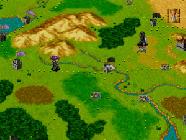
That vision would see an experience that approximates the tabletop war game in a new and innovative way, blending RPG mechanics and story with army building and a quest for continental domination (for all the right reasons of course) while adding a splash of fighting game influence.
As you start the game, youíre treated to a rather wonderful intro which blends western high fantasy themes with Japanese anime production. Itís great at setting the scene of this idyllic kingdom that had been ravaged by vengeful gods in the centuries past. Now with the god Madruk sealed away just long enough for eight chosen warriors to appear.
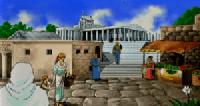
You start the game by choosing one of these warriors, who have each ascended to the throne of their various kingdoms on the continent. Each has their own strengths and weaknesses, their own story and their own cast of supporting characters. They also change how the game plays significantly as well as the story beats.
Quite simply, depending on your playstyle and desired difficulty level, thereís a character for you, and the true master of the game will see through the campaign of every one of those eight monarchs through repeated play. Not that all eight are playable from the start; a few are only selectable after you have finished the story with one of the starting characters.
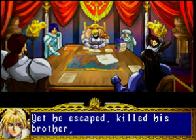
After an opening cinematic you find yourself in the kingdoms court with a few options that weíll come onto later but arenít very useful out of the gate.
Once youíre done there, youíre off into the world of Legendra, and then you see the scale of the task at hand. You rule your kingdom from one or two small castles of dozens on the continent, and those others are ruled by your rival monarchs and independent armies as all on the continent battle for supremacy.
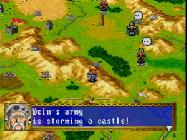
You direct your generals towards the first castle and watch as they travel across the land in search of your first conquest. Soon theyíre storming the castle and the battle sequence is initiated.
And this is what youíre interested in, isnít it?
Battles play with one set of generals and their assigned troops fighting against another. Up to five generals can be deployed when exploring or storming castles, but castles themselves can hold up to 10 generals, which can put attackers at a disadvantage. Something the CPU doesnít usually take advantage of but absolutely something the player should.
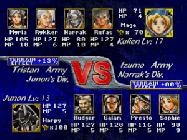
Each general can have an army made up of one of 10 troop types, ranging from standard sword wielding soldiers and cavalry, to samurais, to flying harpies and beast men.
In these early skirmishes you have generals with between 10 and 30 troops, but as you play on, these numbers expand to up to 100 troops serving on the battlefield under the general.
And yes, while it may seem quaint in a post Dynasty Warriors or Total War world, having over 200 warriors battling on screen is impressive on this 30-year-old hardware and itís still a spectacle. Add in the generals and their assorted magic attacks and it looks amazing.
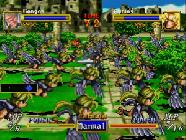
The Saturnís infinite planes are put to good use here as you can see when you pan out of the battlefield. The backgrounds manage multiple layers of parallax while the hordes of warriors and their generals fight on. The game claims to feature ďup to 200 frenzied warriorsĒ on the back of the U.S. game case, but the reality is more impressive than that, with the two generals on screen as well as whatever multi-sprite screen filling magic attacks that they want to launch into battle.
Thatís right, you do more than just command your troops in battle. In fact, the strategies behind your troops are relatively high level. You have access to several formations, depending on the general on the field at the time, with a variety of commands. Each has its own strategic benefits.
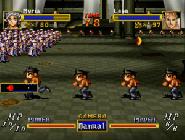
For example, playing defence not only strategically keeps your troops at the rear of your command to project your general, but ups their defensive stats, while other formations will offer strategic and/or stat buffs as well.
Given how troop types play a game of Rock, Scissors, Paper in terms of how effective they are, there is no secret sauce to winning and you will have to adapt based on the class of your troops, and who your enemy has in their ranks.
Ultimately, you donít need to eliminate every soldier on the field, the goal is to defeat the general and the battle doesnít end until their life bar is whittled down or they call a retreat.
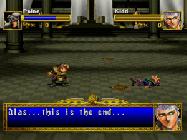
As such, the focus is always on defeating that general, and aside from your troops, you have access to the previously mentioned magic attacks. Your generals have what amounts to an MP gauge and an Active Time Battle bar, and when that bar fills you can cast a magic attack. These attacks range from targeting the troops, buffing your own army or the rival general and range from small purple knives tossed across the field to screen filling explosions and meteor showers.
Again, itís spectacular stuff.
Generals can retreat at any time in the battle, whether theyíve lost substantial troops or not, though doing so eliminates them from the wider skirmish while the winner can fight another round or will take the victory if there are no other generals left.
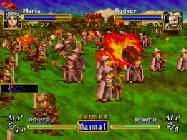
If all troops are depleted on both sides, generals can opt to duel or retreat. Duels pit the opposing leaders against one another like a 2D fighting game, albeit the attacks are fully automated and you can do nothing but watch with trepidation.
While retreating will trigger a loss, depleting a generalís life bar for you or the CPU will mean one of three things: Either the general is captured whereby they can be rescued later or will be forced to join the enemy, theyíre injured and are out of commission for two weeks, or they are killed and lost to Dragon Forceís permadeath. Needless to say, with the danger of the third possibility, a tactical retreat is often the sensible option.
All of these considerations add depth to conflicts across the map. You can always engineer it so you siege a castle with more generals, where their armies have more troops and you have the advantage in numbers, but it by no means guarantees victory if you set up your tactics incorrectly.
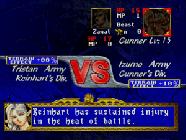
Once youíve conquered an area and hold its castle, you raise the flag of your country, which is cool and adds to the satisfaction of seeing Legendra overflow with your monarchís standard.
But the more castles you hold, the more youíll be under siege yourself from rival kingdoms, bandits and undead armies.
Just as important as winning a castle is when and how to take them, plotting your advances across the map to ensure you have the most protection from enemies by stationing generals at every castle.
Held castles generate troops which can then be recruited to armies. I do find it amusing how agnostic these troops are. Sure you can train to be a soldier or an archer, or even a mage, but how do you say to young Quinten the aspiring knight from Tristan ďyou need to become a dragon-man or a harpyĒ?
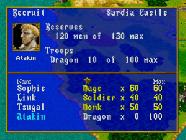
In any case, to hold these castles you need generals stationed there, and they will be beset by various enemies, in particular the endlessly respawning bandits that will continue to ravage your resources.
Itís all deep and fascinating stuff that sits behind a simple interface. Thatís the beauty of Dragon Force. Itís simple and accessible, and light on the sort of micromanagement common to the strategy genre, but has levels of depth for players to get lost in.
Itís not all left on the battlefield or the world map. Every week you return to court to deal with domestic matters. Itís here you can award generals with medals, which increases their troop capacity. Doing so also keeps them happy, as unhappy generals can leave your burgeoning Empire at a moments notice.
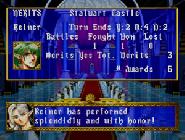
You can also change troop types, equip items, fortify castles and interrogate your captives to turn them to your cause.
Each general can be levelled up, have their stats bolstered, have degrees of satisfaction and weild different items and weapons. This is where Dragon Force really feels more like an RPG than a strategy game, and that goes double for the dialogue and cutscenes throughout the game.
The main campaign as you look to take control of Legendra in order to seek out the eight members of the Dragon Force to combat a resurrected Dark God is amongst the most engaging Iíve played in its era. The satisfaction when toppling a kingdom, the constant pressure from rival forces, the engaging story, itís utterly fantastic.
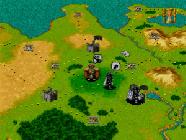
Itís not quite perfect, though. The end game sees you embarking on more linear excursions as you focus on the titular Dragon Force visiting shrines once Legendra has been conquered. Youíre then besieged relentless by respawning dragon armies, which saps on your resources.
The end game is pretty epic, though, with some satisfying final boss battles.
And when youíre done, you unlock the rest of the monarchs as playable characters and can embark of the campaign seven more times, each story slightly different to the last. A huge experience that is very replayable.
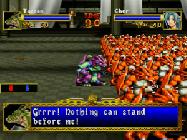
In the eyes of this old gamer, Dragon Force is not only one of the greatest Saturn games, but one of the best games ever made.
When I first owned the PAL version of this game in 1997, I played each campaign multiple times until I could play it no more. Trading it towards a Dreamcast in 1999 remains one of my biggest gaming regrets as its significant cost on the second-hand market is prohibitive. It was only with an ODE that I was able to enjoy this game once again.
And Iíll be honest, when I started it a few months ago, it wasnít to make a video, it was to play for fun. But the game got its claws into me so deeply that I just couldnít put it down. And even after rolling the credits again, Iím raring to go back.
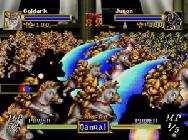
Dragon Force is magical, straddling the lines of multiple genres and using numerous inspirations to create something unique. As an RTS, itís a simple one, but that easy-to-pick-up nature belies depth in other areas whilst making to wider campaign exciting and gratifying.
It remains a stunning and unique experience, and one that demonstrates the 2D power of the Saturn ó hundreds of sprites, layers of parallax, infinite planes. Itís absolutely glorious and gives us spectacle unlike any other 2D game.
And it remains Saturn-only in the West. Yes, there was a Japan-only PS2 port, but the upscaled visuals looked fairly horrendous. I mean, look at the castles on this map and the Vaseline-smeared character pictures. And beyond PS2Ö thatís it!
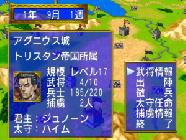 The PS2 Port of the game The PS2 Port of the game
So yes, Dragon Force remains best played on Saturn and is only available on Saturn for non-Japanese speakers.
There are a number of games that can claim to be the Sega Saturnís soul. But a game that is best played and still largely exclusive to the system, that makes exceptional use of its specific strengths and remains an utterly compelling an unique gaming experience is absolutely in contention. Dragon Force is one of those games.
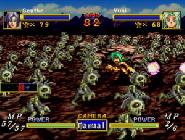
And irrespective of platform, itís a game Iíd urge any player to try out. Itís a shame, in fact, that it is Saturn exclusive, as it fully deserves to be enjoyed by gamers irrespective of platform today. If you get the chance, on real hardware or emulated, you absolutely must try this out.
|
|
The MegaDriver |
| |
Husband, Father of 3, Analyst, Gamer and Half of The SegaGuys podcast.
Dan is a HUGE SEGA fan, and the Saturn is his favorite game console of all time! | |
|
| |
| |
|